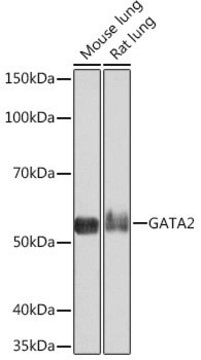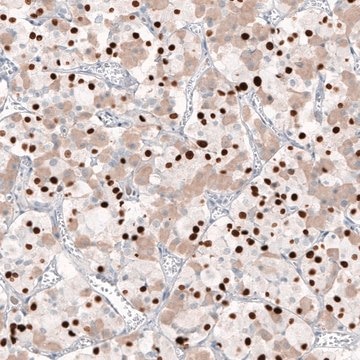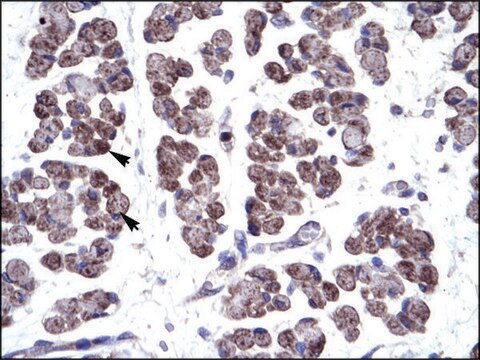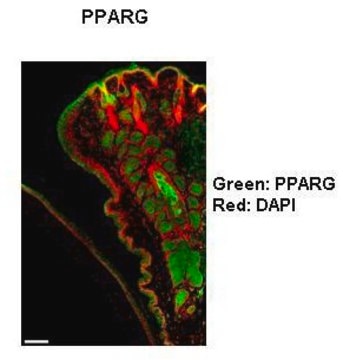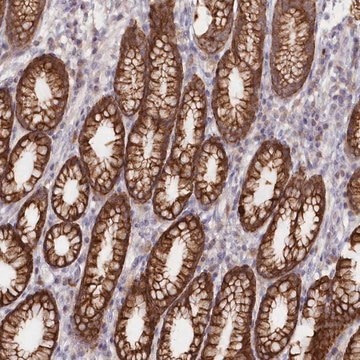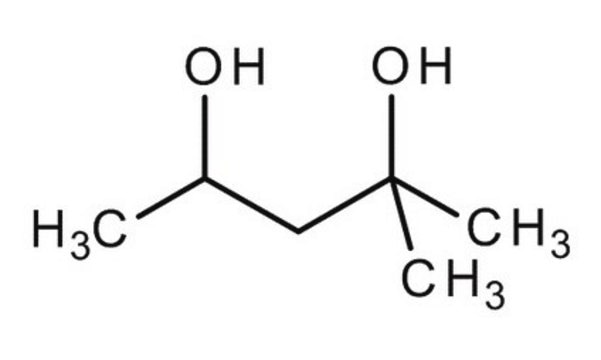General description
Rabbit polyclonal anti-TBX19 antibody reacts with canine, human, mouse, and bovine T-box 19 transcription factors.
T-box 19 (TBX19) is a transcription factor that binds the DNA sequence called T-box found in the promoters of certain genes. T-box genes encode transcription factors that regulate developmental processes. TBX19 is the human ortholog of the mouse Tpit gene that activates pro-opiomelanocortin (POMC) expression by corticotrophs and melaotrophs.
Immunogen
Synthetic peptide directed towards the middle region of human TBX19
Application
Rabbit Anti-TBX19 antibody can be used for western blotting applications at a concentration of 0.5μg/ml.
Rabbit polyclonal anti-TBX19 antibody is used to tag T-box 19 for detection and quantitation by immunocytochemical and immunohistochemical (IHC) techniques. It is used as a probe to determine the presence and roles of T-box 19 in pituitary restricted expression of pro-opiomelanocortin (POMC).
Biochem/physiol Actions
TBX19 is a member of a phylogenetically conserved family of genes that share a common DNA-binding domain, the T-box. T-box genes encode transcription factors involved in the regulation of developmental processes. This gene is the human ortholog of mouse Tbx19/Tpit gene. Studies in mouse show that Tpit protein is present only in the two pituitary pro-opiomelanocortin (POMC)-expressing lineages, the corticotrophs and melanotrophs. Mutations in the human ortholog were found in patients with isolated deficiency of pituitary POMC-derived ACTH, suggesting an essential role for this gene in differentiation of the pituitary POMC lineage.This gene is a member of a phylogenetically conserved family of genes that share a common DNA-binding domain, the T-box. T-box genes encode transcription factors involved in the regulation of developmental processes. Mutations in this gene were found in patients with isolated deficiency of pituitary POMC-derived ACTH, suggesting an essential role for this gene in differentiation of the pituitary POMC lineage. ACTH deficiency is characterized by adrenal insufficiency symptoms such as weight loss, lack of appetite (anorexia), weakness, nausea, vomiting, and low blood pressure. Publication Note: This RefSeq record includes a subset of the publications that are available for this gene. Please see the Entrez Gene record to access additional publications.
Sequence
Synthetic peptide located within the following region: IKYNPFAKAFLDAKERNHLRDVPEAISESQHVTYSHLGGWIFSNPDGVCT
Physical form
Purified antibody supplied in 1x PBS buffer with 0.09% (w/v) sodium azide and 2% sucrose.
Disclaimer
Unless otherwise stated in our catalog or other company documentation accompanying the product(s), our products are intended for research use only and are not to be used for any other purpose, which includes but is not limited to, unauthorized commercial uses, in vitro diagnostic uses, ex vivo or in vivo therapeutic uses or any type of consumption or application to humans or animals.
